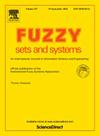Combining thresholded real values for designing an artificial neuron in a neural network
IF 3.2
1区 数学
Q2 COMPUTER SCIENCE, THEORY & METHODS
引用次数: 0
Abstract
This study emanates from a simple observation: as specified by Vapnik [37] in his study, an artificial neural network cannot generate a universal approximator if the aggregation function chosen to design the artificial neuron does not include non-linearity. The usual option is to follow a linear aggregation by a non-linear function, or so-called activation function. We wonder if this approach could be replaced by one using a natively non-linear aggregation function.
Among all of the available non-linear aggregation functions, here we are interested in aggregations based on weighted minimum and weighted maximum operations [8]. As these operators were originally developed within a possibility theory and fuzzy rule framework, such operators cannot be easily integrated into a neural network because the values that are usually considered belong to . For gradient descent based learning, a neuron must be an aggregation function derivable with respect to its inputs and synaptic weights, whose variables (synaptic weights, inputs and outputs) must all be signed real values. We thus propose an extension of weighted maximum based aggregation to enable this learning process. We show that such an aggregation can be seen as a combination of four Sugeno integrals. Finally, we compare this type of approach with the classical one.
结合阈值实值设计神经网络中的人工神经元
这项研究源于一个简单的观察:正如 Vapnik [37] 在他的研究中所指出的,如果设计人工神经元时选择的聚合函数不包括非线性,那么人工神经网络就无法生成通用近似器。通常的选择是用非线性函数或所谓的激活函数进行线性聚合。在所有可用的非线性聚合函数中,我们对基于加权最小值和加权最大值运算的聚合函数感兴趣[8]。由于这些运算符最初是在可能性理论和模糊规则框架内开发的,因此无法轻松集成到神经网络中,因为通常考虑的值属于 [0,1]。对于基于梯度下降的学习而言,神经元必须是一个可根据其输入和突触权重推导的聚合函数,其变量(突触权重、输入和输出)必须都是带符号的实值。因此,我们提出了一种基于加权最大值的聚合扩展,以实现这一学习过程。我们证明,这种聚合可以看作是四个 Sugeno 积分的组合。最后,我们将这种方法与经典方法进行了比较。
本文章由计算机程序翻译,如有差异,请以英文原文为准。
求助全文
约1分钟内获得全文
求助全文
来源期刊

Fuzzy Sets and Systems
数学-计算机:理论方法
CiteScore
6.50
自引率
17.90%
发文量
321
审稿时长
6.1 months
期刊介绍:
Since its launching in 1978, the journal Fuzzy Sets and Systems has been devoted to the international advancement of the theory and application of fuzzy sets and systems. The theory of fuzzy sets now encompasses a well organized corpus of basic notions including (and not restricted to) aggregation operations, a generalized theory of relations, specific measures of information content, a calculus of fuzzy numbers. Fuzzy sets are also the cornerstone of a non-additive uncertainty theory, namely possibility theory, and of a versatile tool for both linguistic and numerical modeling: fuzzy rule-based systems. Numerous works now combine fuzzy concepts with other scientific disciplines as well as modern technologies.
In mathematics fuzzy sets have triggered new research topics in connection with category theory, topology, algebra, analysis. Fuzzy sets are also part of a recent trend in the study of generalized measures and integrals, and are combined with statistical methods. Furthermore, fuzzy sets have strong logical underpinnings in the tradition of many-valued logics.
 求助内容:
求助内容: 应助结果提醒方式:
应助结果提醒方式:


